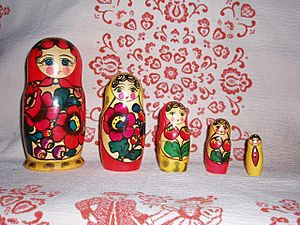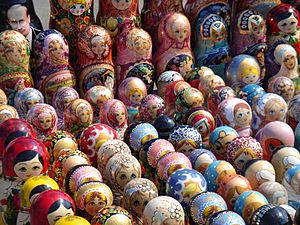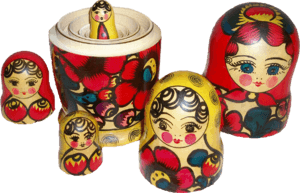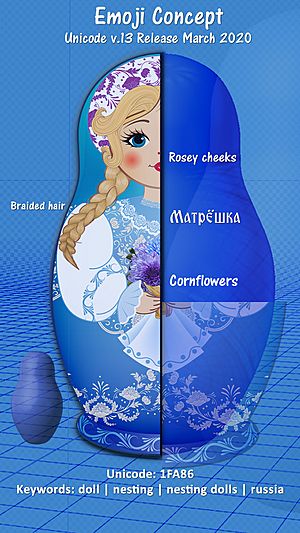Matryoshka doll facts for kids
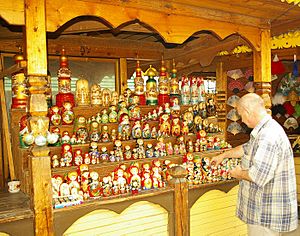
Matryoshka dolls (Russian: матрёшка, IPA: [mɐˈtrʲɵʂkə]), also known as Russian nesting dolls or babushka dolls, are a special kind of wooden toy. They are sets of dolls that fit one inside another, getting smaller and smaller. The word matryoshka means "little matron" in Russian. It comes from the popular Russian girl's name "Matryona" or "Matryosha".
Each matryoshka doll is made of wood and splits in the middle, top from bottom. When you open one, you find a smaller doll inside! This continues until you reach the tiniest doll, which is usually a solid piece of wood.
The very first Russian nesting doll set was created in 1890. A skilled wood turner named Vasily Zvyozdochkin made the dolls, and a folk artist named Sergey Malyutin designed how they looked. Usually, the biggest doll is a woman wearing a traditional Russian peasant dress called a sarafan. The dolls inside can be boys or girls, but the smallest one is often a baby. The painting on each doll is very detailed and beautiful. Often, the dolls in a set follow a certain theme, like characters from a fairy tale or even famous Russian leaders. In many parts of the world, people call them "babushka dolls," because babushka means "grandmother" or "old woman" in Russian.
Contents
How Matryoshka Dolls Are Made
Matryoshka dolls are usually made from linden trees. Many people think they are carved from one single piece of wood, but that's not quite right! They are actually made using special tools and a lot of skill.
Craftsmen use a lathe, which is a machine that spins the wood. They also use different types of chisels to shape the wood. Each set of dolls is carefully carved, piece by piece, to make sure they fit perfectly inside each other. The tools used are often handmade by village blacksmiths!
Fun Themes for Matryoshka Dolls

Matryoshka dolls often have a special theme. For example, they might show peasant girls in traditional clothes. Long ago, the themes were usually from Russian traditions or fairy tales. But since the late 1900s, artists have started making dolls with many different themes.
You can find dolls with nature and flower designs. Some sets are made for holidays like Christmas or Easter. Modern artists create all sorts of new styles, especially for tourists. These can include animal collections, famous people's faces, or even funny caricatures of politicians, musicians, athletes, or movie stars!
Certain areas in Russia are famous for their unique matryoshka styles, like Sergiyev Posad, Semionovo (now Semyonov), Polkhovsky Maidan, and Kirov.
Matryoshka Dolls of Leaders
In the late 1980s and early 1990s, during a time called Perestroika when Russia became more open, dolls featuring the leaders of the Soviet Union became very popular. The biggest doll would often be the leader at that time, like Mikhail Gorbachev. People even called these dolls Gorba or Gorby dolls!
As new leaders came to power after the Soviet Union ended, newer sets of dolls would feature Russian presidents like Boris Yeltsin, Vladimir Putin, and Dmitry Medvedev.
Most political matryoshka sets show the current leader as the largest doll. Then, the dolls get smaller as they show leaders from the past, like Leonid Brezhnev, Nikita Khrushchev, Joseph Stalin, and Vladimir Lenin. Sometimes, even very old Russian rulers called Tsars, like Nicholas II and Peter the Great, are included.
Political matryoshka sets usually have between five and ten dolls.
World Record for Matryoshka Dolls
The biggest set of matryoshka dolls ever made has 51 pieces! It was hand-painted by Youlia Bereznitskaia from Russia in 2003. The tallest doll in this amazing set is about 54 centimeters (21 inches) tall. The smallest doll is tiny, only about 0.3 centimeters (0.12 inches)! If you lined up all 51 dolls side-by-side, they would stretch over 3.4 meters (11 feet) long.
What Matryoshka Dolls Symbolize
Matryoshka dolls are often seen as a symbol of the feminine side of Russian culture. They are connected to ideas of family and having children in Russia.
The dolls can represent a mother carrying a child inside her, and how families pass down their history from one generation to the next. They can also show how different parts of us, like our body, soul, mind, heart, and spirit, are connected and fit together.
The idea of matryoshka dolls is also used as a way to describe other things. This is called the "matryoshka principle" or "nested doll principle." It means when you have an object inside a similar object, and so on. For example, some computer designs or even tiny carbon tubes are described using this idea.
It's a bit like an onion: when you peel off an outer layer, you find a similar onion inside. This idea is used in many designs, like clothes that layer or tables that fit inside each other.
Matryoshka Doll Emoji
In 2020, the Unicode Consortium (the group that decides on new emojis) approved the matryoshka doll as a new emoji! It's part of the v.13 emoji release. The idea for the matryoshka doll emoji was suggested by Jef Gray. He wanted a symbol that represented Eastern European culture in a way that was not about religion or politics.
Images for kids
See also
 In Spanish: Matrioshka para niños
In Spanish: Matrioshka para niños


